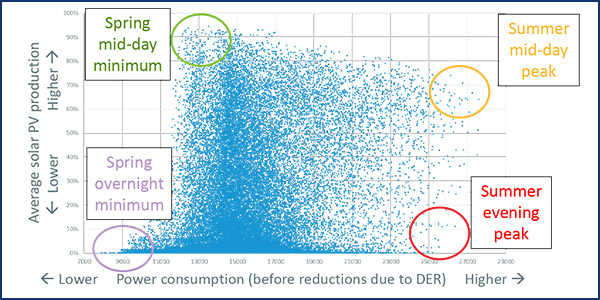ISO-NE is proposing a pilot study for its “Transmission Planning for the Clean Energy Transition” effort that would test grid performance assumptions under scenarios of high renewable penetration and quantify the tradeoffs between transmission investment and less system flexibility.
The pilot study would take a “10,000-foot view” of the entire New England system, rather than a portion of it, according to Dan Schwarting, a transmission planning supervisor for the RTO.
The goal is to identify the overall trend of system behavior and reliability concerns as more renewables are brought online, not to identify exact needs or system upgrades. Base cases will represent a likely dispatch for a given condition rather than stress any specific portion of the system through generator outages.
The RTO said steady-state N-1-1 analysis on the entire system is feasible because of recent study automation efforts. Stability analysis will concentrate on faults on the 345-kV system and 230-kV or 115-kV faults that are incredibly impactful. Limited electromagnetic transient study work may be pursued as well.
Schwarting said the results of the pilot study will be most useful if it begins with fairly conservative conditions, such as high wind generation when low inertia may be a concern and low wind generation where load serving may be an issue. He said it would also investigate potential paths to address reliability concerns through transmission system investment, operational measures and policy changes.
Any reliability problems found would not be immediately addressed in a solutions study or competitive request for proposals. The proposed transmission solutions would be representative only, and costs would be order-of-magnitude estimates.
The results of the pilot study would inform decisions on assumptions to be used in future transmission needs assessments.
Additionally, certain study assumptions are affected by policies both inside and outside ISO-NE’s purview, such as distribution system power factor, distributed energy resource voltage and frequency control capability, and DER fault ride-through capability. Initially, the pilot study will assume a “business-as-usual” approach to these policies. If changes to the policies promise benefits, they will be considered as mitigating measures. However, the RTO wants reasonable assurance that these policies would be implemented and enforced before it could rely on them in future needs assessments.
Schwarting said that many stakeholders provided comments during and after his PAC presentation in September. (See “Proposed Study Conditions to Meet Challenges in Transmission Planning,” ISO-NE Planning Advisory Comm. Briefs: Sept. 24, 2020.)
The feedback related to study conditions centered on two questions: How likely are the proposed study conditions to occur, and can operational measures ensure reliability in those conditions?
The DER and storage policies-related feedback and questions from stakeholders included: Would the implementation of voltage and/or frequency control on DERs mitigate reliability concerns? Also, could better rules around the behavior of storage assets address peak- and minimum-load conditions?
Stakeholders may submit feedback on the pilot study proposal until Dec. 4, and the next steps include the development and review of the base cases. The analysis will begin in late 2020 or early 2021. The RTO will reach out to distribution providers regarding DER data collection in parallel to the pilot study.
Preliminary Production Cost from Economic Study Presented
ISO-NE presented preliminary production cost results to the PAC for the 2020 Economic Study requested by National Grid. The utility asked for a one-year study focused on 2035 to provide stakeholders analyses of the best ways to meet state clean-energy goals cost-effectively, leveraging transmission and storage as needed.
Richard Kornitsky, ISO-NE’s assistant engineer for system planning, said the introduction of bidirectionality across existing ties causes a reduction of spillage during situations of low load and high-variable resource production. Total systemwide spillage is relatively low compared to the New England States Committee on Electricity case of 8,000 MW spilled because of the RTO’s assumption of high load in 2035.
Because emissions associated with imports from Hydro-Québec and New Brunswick are assumed to be zero, the impact of energy banking of non-emitting New England resources is not apparent in many of the systemwide metrics. Natural gas production is replaced by adding new ties with firm low threshold-price import capability from Hydro-Québec.
The study used bidirectional threshold prices reflecting renewable energy credit values, first-to-curtail imports, then trigger exports, with renewables curtailed once export capability is exhausted. The prices ranged from -$100/MWh for behind-the-meter PV to -$30/MWh for onshore wind. The trigger for exports is assumed at -$25/MWh.
Kornitsky asked for any feedback or comments by Dec. 1, including possible sensitivity scenarios. The next steps include identifying sensitivity scenarios and assumptions for the PAC meeting on Dec. 16, presenting assumptions for ancillary services analysis and draft results in the first quarter of 2021. The final report is expected in the second quarter of 2021.



